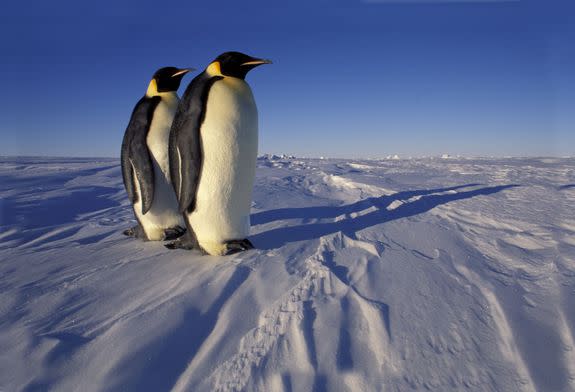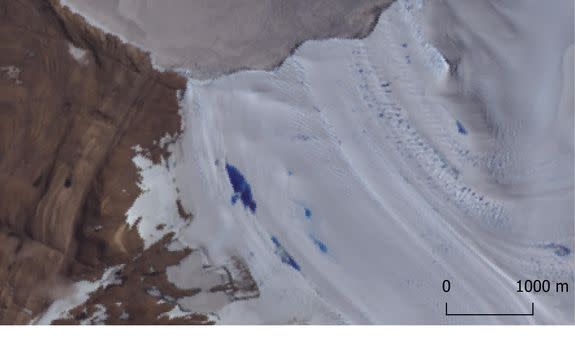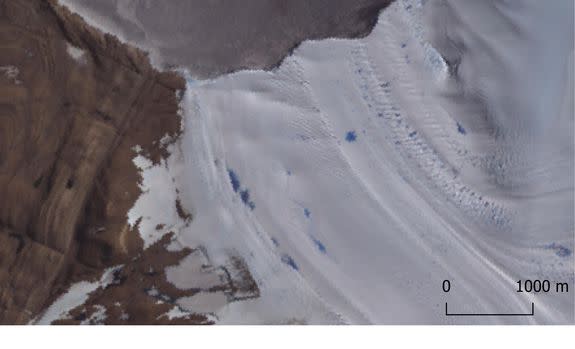Blue lakes on an East Antarctic glacier are a troubling sign, scientists say

British researchers have discovered a troubling trend in East Antarctica: As air temperatures become warmer each summer, more and deeper lakes are showing up atop Langhovde Glacier.
Their study, published this month in the journal Geophysical Research Letters, is the first to monitor the meltwater pools for an extended period of time in that part of the icy continent.
SEE ALSO: A lengthening crack is threatening to cause an Antarctic ice shelf to collapse
The findings are significant because they add to mounting evidence that an area once considered the most stable part of Antarctica is now showing signs of increased melting — this time from a process that has sped up the melting taking place in Greenland.

Image: ullstein bild via Getty Images
Surface melting can weaken glaciers by causing cracks in the ice and making the glacier’s underbelly more slippery, speeding or enabling the ice to slide into the sea. These and other processes can contribute to global sea level rise, which is already damaging coastal communities.
The fate of the Antarctic ice sheet, particularly East Antarctica, will help determine how high sea levels rise during the next several decades to centuries in response to human-caused global warming.
The surface lakes on Langhovde Glacier are relatively shallow and small, especially compared to the larger pools seen in Greenland.
But that could change if warmer-than-average summers happen more often due to climate change, the research team from Durham University and Lancaster University in England found.

Image: DigitalGlobE
"The warm years are expected to become more frequent in the future, so we might expect to see even more lakes and even deeper lakes in the future," Amber Leeson, one of the study's co-authors and an expert on ice-climate interactions at Lancaster's Environment Center, told Mashable by phone.
"It's not just lakes forming and refreezing in the winter," she added. "They're forming, draining and feeding into a wider 'subglacial' hydrological network. And no one has really thought of that before in East Antarctica."
Summer meltdown
For their study, the team studied about 150 satellite images of Langhovde Glacier taken between 2000 and 2013 during the November-to-February summer season. They compared those with meteorological records for the same period, gathered at a nearby research base.

Image: Jay Zwally/Journal of Glaciology
The team mapped about 8,000 lakes, although the actual number of lakes on the glacier is likely much smaller than 8,000, said Emily Langley, the study's lead author and a Master's candidate in Durham's Department of Geography.
The researchers counted all the lakes that appeared in satellite images, so the same lakes may have appeared in multiple images and been counted two or more times, Langley said. She explained it was too difficult to quantify the precise number of surface lakes — but the quantity wasn't the most important factor in their study.
"Our research was very much looking at the correlation of the lake size and depth with the surface air temperature," she told Mashable in a phone interview. "It tells us their sensitivity [to warmer summers]."

Image: LightRocket via Getty Images
The lakes on Langhovde Glacier formed when temperatures rose above 0 degrees Celsius (32 degrees Fahrenheit). And they formed most frequently during the summer of 2012-2013, which saw 37 days with temperatures above the freezing point, the study found.
Disappearing lakes
So far, the glacial lakes are probably not deep enough to compromise the ice sheet or the floating ice shelf, Langley said. But researchers did see two lakes disappear, meaning the water likely drained into the core of the glacier.
The ice sheet is the part of the glacier that sits on top of land, while the ice shelf is like a canopy, attached to the sheet but protruding into the ocean. Ice flow travels outward, from ground to sea, and can break the ice sheets down into free-floating icebergs.

Image: Land Processes Distributed Active Archive Center/NASA Earth Science Data and Information System project

Without the buffer of an ice shelf, the grounded ice can flow straight into the ocean, causing substantial sea level rise. NASA projected that the West Antarctic Ice Sheet could disgorge enough ice to drive devastating levels of sea level rise — about 16 feet, or 5 meters, if its Ross Ice Shelf were to melt.
In Greenland, which has been seeing far more ice loss than East Antarctica, scientists have observed surface lakes drain within 24 hours after forming.
The Durham-Lancaster team said they saw two very small lakes disappear over a week-long period in January 2005. It's likely the first time lake drainage has been documented in East Antarctica, according to the researchers.
"It shows that this is something that can potentially impact the flow of the ice sheet," Leeson said.
"If [the lakes] get bigger in the future, we potentially might start to see the same effect that lakes have in Greenland happening in Antarctica."
A separate study from March found that surface melt could greatly accelerate Antarctic ice loss by raising the risk of "hydrofracture," which happens when water formed by the melting of snow and ice atop ice shelves causes them to disintegrate.
The process is one reason why several Greenland glaciers are starting to destabilize, according to research that Rob DeConto of the University of Massachusetts, Amherst, and David Pollard of Penn State published in the journal Nature.
The researchers described a catastrophic scenario if countries fail to reduce greenhouse gas emissions and Antarctica continues to melt.
"Antarctica has the potential to contribute more than a meter [3.3 feet] of sea-level rise by 2100 and more than 15 meters [49 feet] by 2500, if emissions continued unabated," they warned.
